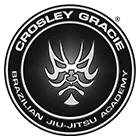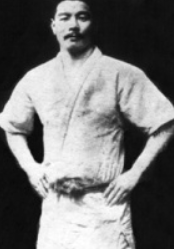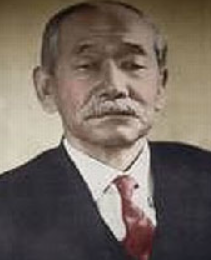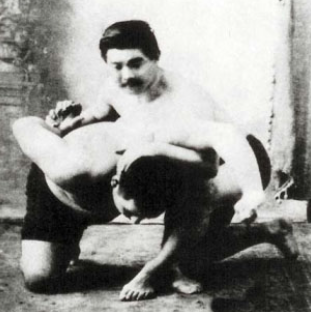About Mitsuyo Maeda
Mitsuyo Maeda was born in 1878 in a small town called Aomori, located north to the Japanese island of Honshu and known for its freezing winters. As poverty assailed the region at the end of the 19th century, many inhabitants would move to Tokyo or other cities to try and make money and escape the cold.
This was not the case for young Maeda, who remained there till 1886, when he finally moved to the capital. While he resided in Aomori, he went to Hirosaki School, of the local elite, where he was known as the “sumo-kid,” because of his fascination for the art his father had taught him. And, of course, for the several fights he would win against schoolmates.
As he arrived in Tokyo, Maeda started going to one of the country's most traditional schools and, later, entered a high-class university, nowadays called Waseda, and acknowledged as a great teaching center. There he was taught the techniques of classical Jiu-Jitsu. Later on, he would knock on the door of Kodokan, a famous Judo academy that works to this day and at the time was already deemed the best martial arts centre in Japan.
The eventual master and founder of the academy, Jigoro Kano, was a studious man who gathered many styles of ancient Jiu-Jitsu to create Judo, whose apex was reached in 1964, when it began to appear in the Olympic Games, in Tokyo. But that would happen long after Maeda's day.
At that time, Kano had just modified the art and left out the elements and techniques and striking inherited from the samurais, who used to learn fighting techniques for when their swords broke in the battlefields. An art, therefore, bereft of the rules, which characterize today's Judo – and Jiu-Jitsu.
In that period, fights were held every month at Kodokan. It is suspected that Maeda practiced hard for months before premiering in these competitions, for he didn't want to risk doing badly in them. On December 25, 1898, he finally made his first (and amazing) demonstration at the academy. Wearing a white belt, he easily beat five or six opponents and was immediately promoted to purple-belt. That same day, while the westerns celebrated Christmas, Maeda would go on to defeat more and more adversaries until, after overcoming 15 fighters in a row, he was granted the first degree of the black belt. There began the trajectory of an incredible competitor.
A man of average build, measuring 5'6" and weighing 150lb, Maeda wasn't quite what one would call intimidating. He loved drinking sake, singing, and wouldn't back off whenever challenged to fight on the street. He wouldn't take long to take or knock down the naïve challenger. Constantly evolving, he was promoted to the third degree in 1901 and became a Judo instructor at the Universities of Tokyo, Waseda and Gakushuin.
In 1904, Master Jigoro Kano summoned prodigy-pupil Maeda to travel to the United States in order to propagate Judo. Before the “ambassador” left, he received the fourth degree by the hands of his professor.
Mitsuyo Maeda left the Yokohama port in November, arriving in San Francisco, California, soon before the en of the year. At the time, North-Americans already knew a bit about Japanese martial arts, since president Theodore Roosevelt, was a big fan of the Japanese people and its culture – he even had a Jiu-Jitsu tutor called Yamashita.
In order to improve their self-defense, some American military men were already learning the art at their headquarters. But to demonstrate the efficacy of the “new” art created by Kano, Maeda and his mates were appointed to fight the Americans and prove the Japanese superiority. In the famous military school of New York, Maeda faced a football player who also practiced wrestling. After falling inside the guard, his back to the floor, which in wrestling rules would mean he lost, Maeda continued the move and ended it with an arm lock.
The Americans didn't accept the submission and proposed a new challenge, this time against Maeda's mate, an experienced student of Kano's called Tomita. The Yankees believed facing Tomita would be a greater honor, because he was a more experienced fighter (actually, Tomita was much more of a professor than a fighter).
Unfortunately, Tomita was embarrassingly defeated, for his opponent managed to transpose his legs and immobilize him. This was too much for Maeda, who decided to separate from Tomita and establish himself in New York, where he maintained himself by taking part in underground challenges. In the first of these, in front of a wrestler a foot taller and who liked to be called “The Butcher,” Maeda knocked the adversary down several times before finishing with an arm lock. Three fights and three wins later, Maeda decided to challenge the world heavyweight boxing champion, Jack Johnson, considered by some specialists to be the best boxer of all time. Thus the Japanese began the tradition that would be followed by the Gracie's of challenging the boxing champion of their day (Helio challenged Joe Louis, whereas Rickson aimed at Mike Tyson). The boxers also created a tradition of their own: that of never responding to such challenges.
Three years later, in 1907, Maeda went to the United Kingdom, where he won 13 more fights, then heading to Belgium, where again he won. He went back to America, this time to Cuba. There he reigned undisputed. He achieved no less than 15 victories, plus four when he passed by Mexico. And this is only the fights with official records. If we count street challenges, in Cuba alone we are talking something like 400 bouts.
Since he parted from Tomita, in the USA, Maeda had become independent and, in his travels, he insisted on calling his art Jiu-Jitsu. This choice may have come from the fact that, before entering Kodokan, he was already familiar with classical Jiu-Jitsu, and probably used in his fights many of the moves Jigoro Kano had banned in creating Judo. Naturally, Kodokan's strict principles wouldn't approve of Maeda's challenges, and this may have been another reason for the adoption of the name Jiu-Jitsu.



